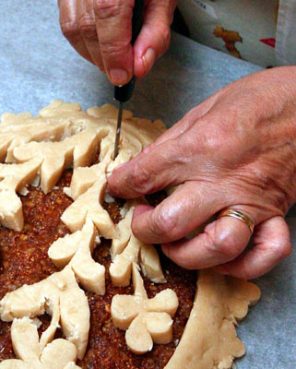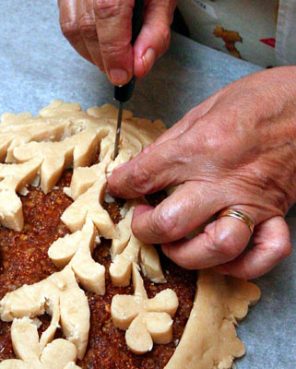
(RNS5-MAR19) Sandra Scalise Juneau, a master of Sicilian pastry art, demonstrates how to make cuccidata (Italian fig cakes) for St. Joseph Day at the Southern Food & Beverage Museum in New Orleans. For use with RNS-NOLA-STJOE, transmitted March 19, 2009. Religion News Service photo by Danny Bourque/The Times-Picayune.

(RNS5-MAR19) Sandra Scalise Juneau, a master of Sicilian pastry art, demonstrates how to make cuccidata (Italian fig cakes) for St. Joseph Day at the Southern Food & Beverage Museum in New Orleans. For use with RNS-NOLA-STJOE, transmitted March 19, 2009. Religion News Service photo by Danny Bourque/The Times-Picayune.
NEW ORLEANS — Sandra Scalise Juneau’s little knife never stopped moving as it traced a pattern through the top of the dough.
Among those watching her at the Southern Food and Beverage Museum were many of the women (and some men) who create works of art in dough that adorn many prominent altars that honor of St. Joseph on his feast day, March 19.
They had come to see a master at work. The woman before them, wearing a white apron and a bandanna over her hair, has made these works of culinary art for museums, including the St. Joseph altar on permanent display at SoFAB.
Juneau uses her grandmother’s tools to carve lacy flower designs into the top of large cuccidata, the elaborate fig cakes that are among the most intriguing foods on St. Joseph’s altars.
“This one is telling me it wants to be a heart,” Juneau said as she rolled out the dough for the first cuccidata. An hour later, the flaming heart symbolizing Mary was finished, complete with quilling representing the fire at the top. Four flowers sprang from a single vine, the emblem of unity in Christ that Juneau’s grandmother had always emphasized.
In another hour, she had completed an elaborately decorated staff, the symbol of St. Joseph. The attendees nibbled her small cuccidatta cookies, and an equally delicious chocolate-wine ball biscotti.
As the story goes, Sicilians erected the first St. Joseph altar after their patron saint delivered them from a devastating famine. The grateful Sicilians prepared a lavish table with the food they had prepared, and then distributed the food to the less fortunate.
Today, St. Joseph altars are three-tiered structures topped with a St. Joseph statue surrounded by flowers and greenery. The food is all meatless — St. Joseph Day usually falls during Lent, after all. Several foods have symbolic meaning (bread crumbs to represent the carpenter’s saw dust), and prayer petitions are collected in small baskets.
They’re big, lavish affairs that are erected all over town. And Juneau has become a sought-after expert in how to put them together.
Juneau’s grandmother created one of the family’s first altars in gratitude for the end of World War II. As happened many times in New Orleans, the altar outgrew the family home above the grocery store. It moved to The Convent of the Good Shepherd.
“In my family, they were meticulous about the linens, about the colors,” Juneau says. “They were so particular about artistically displaying it.” The altar her grandmother supervised also was bountiful, serving thousands of people in two days.
Juneau remembers the exciting year, when she was 6 years old and chosen to portray Mary in a Holy Family ceremony. “I grew up watching this whole process,” she said. “When I got old enough to really zero in, I was fascinated by my grandmother’s technique of carving the fig cakes. Every year I would say, `Please teach me that.’ She was so busy she would say, `Next year, next year.’ She never really did teach me.”
Juneau’s grandmother died before she could pass on the artistry, and Juneau and her mother collected family recipes from her great-aunts.
“I had them show me how to do this process. I picked up my grandmother’s tools. To this day, it’s almost like her hand is guiding me. It truly is a spiritual experience, a connection,” Juneau says.
The resulting cakes and display were a huge hit. And it became Juneau’s mission to transmit her knowledge, to teach others about the spirit of community involved. She did more and more altar work, teaching different groups. Every time she traveled, she sought out Italian groups to teach.
The altar custom came to New Orleans with the huge wave of Sicilian immigrants at the turn of the 20th century. People take the tradition with them when they leave the area, Juneau notes, so that altars now can be found in Phoenix, Dallas, Atlanta and other cities.
She points out that the custom has transcended the Sicilian community and has been embraced by the Vietnamese, Hispanic and African-American communities. “When you see their altars, they’re totally unique and have their own cultural spin on them. The symbolism is meaningful to them. It’s fascinating,” Juneau says.
The highlight of Juneau’s altar experiences is a trip to Italy two years ago. In Sicily, with an interpreter, she scheduled a baking day in her grandmother’s town, where there remain only two women who know how to make these cakes.
“It was extraordinary,” Juneau says, “so uncanny. The way the figs are prepared is exactly the same way my grandmother did. The dough recipe was exactly the same, except we use Crisco and they use lard. The use of lard gives the dough a gleam that’s absolutely gorgeous. But the cakes are the same.”
Traditions morph, Juneau points out, and so she is always careful to point out that she is teaching the recipes that were handed down to her, which may be different from recipes handed down from other forebears.
“If it’s going to live, it has to change,” Juneau says. “… People say it’s a labor of love, but it’s really more about the love than the labor.”
(Judy Walker is the food editor for The Times-Picayune in New Orleans.)
(OPTIONAL TRIM/SIDEBAR FOLLOWS)
Sandra Scalise Juneau’s Cuccidata (Sicilian Fig Cookies)
Makes several dozen
FIG FILLING
2 pounds dried Greek figs
1 tablespoon cinnamon
4 tablespoons honey
2 tablespoons orange zest
Scant pinch black pepper (about 1/8 teaspoon)
Remove stems from figs. Rinse thoroughly in warm water to soften. Drain.
Season figs with cinnamon, mixing thoroughly. Coat with honey, then add orange zest and black pepper, blending thoroughly. Grind fig mixture, using an electric meat grinder (not a food processor), to a fine texture.
After mixture is ground, mix thoroughly to blend all ingredients. Separate into 1- or 2-pound packages, wrapped in plastic food wrap and sealed in plastic bags. (Keep several weeks, refrigerated, or freeze for up to 6 months.)
CUCCIADATA DOUGH
5 cups plain flour
3/4 cup vegetable shortening
3/4 cup sugar
1 to 2 cups warm water
Add shortening to flour and blend (by hand or food processor) to a cornmeal texture.
In another bowl, add warm water (not boiling) to sugar to dissolve. Gradually add sugar/water to flour mixture, blending until dough forms a ball. If dough is too dry, gradually add more water as needed. Cover and let dough rest for 10 minutes.
Separate dough into workable-sized balls, about 3 inches across. Knead each ball to a smooth texture and return to bowl. Cover again; let dough rest several more minutes.
Roll a 2-inch ball of dough to the thickness of pie pastry. Cut dough into strips about 4 inches wide by 12 inches long. Shape a piece of the fig filling into a rope about 1/2 inch wide and 12 inches long. Center the rope on a strip of pastry. Fold sides of pastry over filling, overlapping dough slightly. Turn over with seam side down and pat lightly to flatten.
With a sharp small knife, cut the rope at an angle into 1-inch long bars, cutting slits in sides and one on top to allow for thorough cooking. Place on cookie sheets. Bake in a preheated 250-degree oven for about 20 to 30 minutes, until cookies are slightly browned on the bottom only.
Allow to cool before icing.
ICING
2 drops almond extract
1 tablespoon milk
2 cups powdered sugar
Colored non-pareils
Add almond flavoring to milk and gradually blend into sugar, mixing to a smooth paste. Icing should be the texture of heavy cream.
Working over a small bowl, spoon icing onto each (cooled) cookie. Let excess drip into the bowl. Let cookie dry slightly before sprinkling with colored non-pareils.
Cookies must dry completely before packaging.




